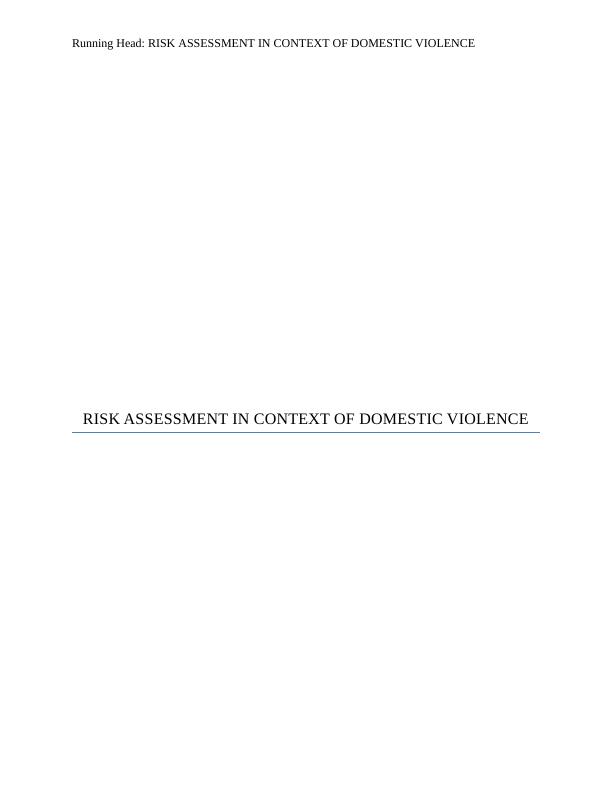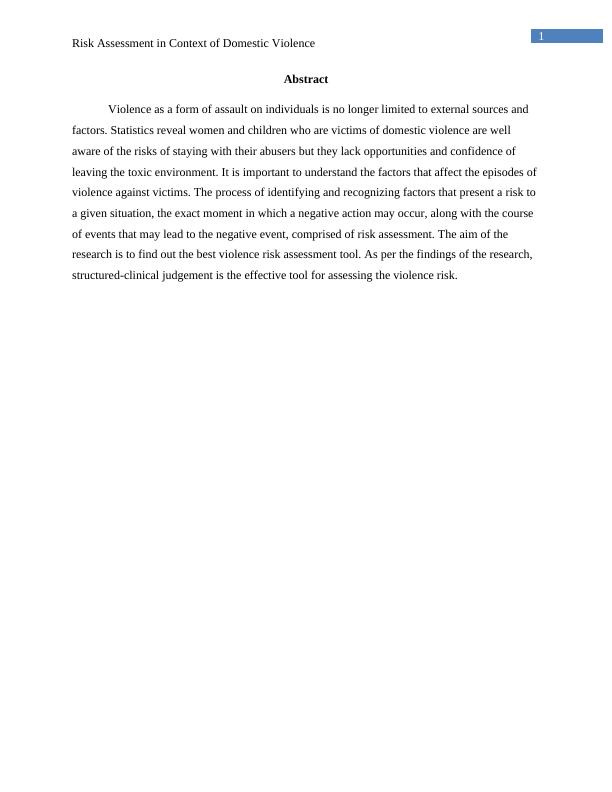Risk Assessment in Context of Domestic Violence
Added on 2023-06-04
11 Pages3206 Words435 Views
Running Head: RISK ASSESSMENT IN CONTEXT OF DOMESTIC VIOLENCE
RISK ASSESSMENT IN CONTEXT OF DOMESTIC VIOLENCE
RISK ASSESSMENT IN CONTEXT OF DOMESTIC VIOLENCE

1
Risk Assessment in Context of Domestic Violence
Abstract
Violence as a form of assault on individuals is no longer limited to external sources and
factors. Statistics reveal women and children who are victims of domestic violence are well
aware of the risks of staying with their abusers but they lack opportunities and confidence of
leaving the toxic environment. It is important to understand the factors that affect the episodes of
violence against victims. The process of identifying and recognizing factors that present a risk to
a given situation, the exact moment in which a negative action may occur, along with the course
of events that may lead to the negative event, comprised of risk assessment. The aim of the
research is to find out the best violence risk assessment tool. As per the findings of the research,
structured-clinical judgement is the effective tool for assessing the violence risk.
Risk Assessment in Context of Domestic Violence
Abstract
Violence as a form of assault on individuals is no longer limited to external sources and
factors. Statistics reveal women and children who are victims of domestic violence are well
aware of the risks of staying with their abusers but they lack opportunities and confidence of
leaving the toxic environment. It is important to understand the factors that affect the episodes of
violence against victims. The process of identifying and recognizing factors that present a risk to
a given situation, the exact moment in which a negative action may occur, along with the course
of events that may lead to the negative event, comprised of risk assessment. The aim of the
research is to find out the best violence risk assessment tool. As per the findings of the research,
structured-clinical judgement is the effective tool for assessing the violence risk.

2
Risk Assessment in Context of Domestic Violence
Introduction
Domestic violence is a kind of aggressive or violent behaviour found within the home
that involves violent abuse of a partner or spouse (Stets, 2012). White Ribbon Australia is a
campaign that works to end violence against girls and female. According to this campaign,
domestic violence refers to the act of intimidation between people who share an intimate
relationship with each other (Whiteribbon.org.au, 2018). A perpetrator tries to dominate and
control another person by using domestic violence. Domestic violence is considered as a
violation of individual rights. It causes physical harm, psychological harm and fear among
individuals. Domestic violence in Australia mainly includes sexual assaults, physical assaults,
psychological abuse, and verbal financial and emotional abuse of individuals.
On statistics created by the Australian Institute of Criminology and the Australian Bureau
of Statistics, one in every three women has experienced physical violence at home since they
were 15 years old (Abs.gov.au, 2018). Women with children are the most common victim of
domestic abuse. On an average, every two minutes a woman somewhere in Australia is
becoming a victim of domestic assault and abuse. Women are more likely to be hospitalized in
Australia as a victim of domestic violence and are more prone to report fear of life from their
domestic partners.
The health, administration and social welfare costs of violence against women and
children are projected to increase at an alarming rate if steps are not taken to prevent such issues
Domestic violence against women is categorised into three major types- physical,
emotional and financial.
Physical violence comprises times when physical force is used against a person by
another person (Desmarais et al., 2012). Signs of physical abuse include shaking, slapping,
pushing, kicking, choking, using weapons as a means to threaten, driving dangerously,
destroying property, abuse of children and pets, locking individuals away from friends and
family, physical restraint, sleep and food deprivation. Abusive domestic relationships often have
Risk Assessment in Context of Domestic Violence
Introduction
Domestic violence is a kind of aggressive or violent behaviour found within the home
that involves violent abuse of a partner or spouse (Stets, 2012). White Ribbon Australia is a
campaign that works to end violence against girls and female. According to this campaign,
domestic violence refers to the act of intimidation between people who share an intimate
relationship with each other (Whiteribbon.org.au, 2018). A perpetrator tries to dominate and
control another person by using domestic violence. Domestic violence is considered as a
violation of individual rights. It causes physical harm, psychological harm and fear among
individuals. Domestic violence in Australia mainly includes sexual assaults, physical assaults,
psychological abuse, and verbal financial and emotional abuse of individuals.
On statistics created by the Australian Institute of Criminology and the Australian Bureau
of Statistics, one in every three women has experienced physical violence at home since they
were 15 years old (Abs.gov.au, 2018). Women with children are the most common victim of
domestic abuse. On an average, every two minutes a woman somewhere in Australia is
becoming a victim of domestic assault and abuse. Women are more likely to be hospitalized in
Australia as a victim of domestic violence and are more prone to report fear of life from their
domestic partners.
The health, administration and social welfare costs of violence against women and
children are projected to increase at an alarming rate if steps are not taken to prevent such issues
Domestic violence against women is categorised into three major types- physical,
emotional and financial.
Physical violence comprises times when physical force is used against a person by
another person (Desmarais et al., 2012). Signs of physical abuse include shaking, slapping,
pushing, kicking, choking, using weapons as a means to threaten, driving dangerously,
destroying property, abuse of children and pets, locking individuals away from friends and
family, physical restraint, sleep and food deprivation. Abusive domestic relationships often have

3
Risk Assessment in Context of Domestic Violence
a cycle where there are periods of calmness followed by sudden outbursts of tension and
violence (Eriksson & Mazerolle, 2015).
Emotional violence on a woman does not leave any physical scars but affects the mental
well being of individuals (Stets, 2012). Anxiousness, depression and suicidal tendencies develop
within women suffering from emotional abuse from their partners. Most physical abusers resort
to emotional abuse to be in control over their victims.
Financial abuse on a woman occurs in a variety of methods, mostly when their living
collaborates gradually takes control of the woman’s finances (Stets, 2012). Several signs of
financial abuse are taking complete control over a woman’s finances, bank accounts
chequebooks etc, faking identity of the woman in order to gain credit in her name, taking away
the woman’s weekly allowance or giving her too little allowance.
Discussion
Structured-clinical judgement is a method of risk assessment through which risk
formulations are discussed (Monahan, 2012). This is considered as a most commonly used
method in violence risk assessment. The key focus of this assessment tool it to predict future
violence. This is a highly reliable and accurate tool. This tool analyses specific cases to identify
male violent offenders. Clinicians are called to use their intuition and experience while
performing violence risk assessments. While making judgements about violence, clinicians
prefer to assess the emotional state of offenders. Emotional traits such as anger, lack of empathy
along with behavioural and physiological traits such as flared nostrils, clenching of hands and
jaws, flushed face are considered as the indicators of violence. Such indicators cannot be
detected through other risk assessment tool.
Structured-clinical judgement can be referred to as guided clinical approach and
structured professional judgement. In this approach, assessors have to follow certain guidelines,
which include specific risk factors. Such risk factors are both dynamic and static. These are
determined based on general and theoretical empirical support. The guidelines also include
several recommendations for communication opinions, information gathering and violence
prevention strategies (Smith & Humphreys, 2018). However, this violence risk assessment tool
Risk Assessment in Context of Domestic Violence
a cycle where there are periods of calmness followed by sudden outbursts of tension and
violence (Eriksson & Mazerolle, 2015).
Emotional violence on a woman does not leave any physical scars but affects the mental
well being of individuals (Stets, 2012). Anxiousness, depression and suicidal tendencies develop
within women suffering from emotional abuse from their partners. Most physical abusers resort
to emotional abuse to be in control over their victims.
Financial abuse on a woman occurs in a variety of methods, mostly when their living
collaborates gradually takes control of the woman’s finances (Stets, 2012). Several signs of
financial abuse are taking complete control over a woman’s finances, bank accounts
chequebooks etc, faking identity of the woman in order to gain credit in her name, taking away
the woman’s weekly allowance or giving her too little allowance.
Discussion
Structured-clinical judgement is a method of risk assessment through which risk
formulations are discussed (Monahan, 2012). This is considered as a most commonly used
method in violence risk assessment. The key focus of this assessment tool it to predict future
violence. This is a highly reliable and accurate tool. This tool analyses specific cases to identify
male violent offenders. Clinicians are called to use their intuition and experience while
performing violence risk assessments. While making judgements about violence, clinicians
prefer to assess the emotional state of offenders. Emotional traits such as anger, lack of empathy
along with behavioural and physiological traits such as flared nostrils, clenching of hands and
jaws, flushed face are considered as the indicators of violence. Such indicators cannot be
detected through other risk assessment tool.
Structured-clinical judgement can be referred to as guided clinical approach and
structured professional judgement. In this approach, assessors have to follow certain guidelines,
which include specific risk factors. Such risk factors are both dynamic and static. These are
determined based on general and theoretical empirical support. The guidelines also include
several recommendations for communication opinions, information gathering and violence
prevention strategies (Smith & Humphreys, 2018). However, this violence risk assessment tool

End of preview
Want to access all the pages? Upload your documents or become a member.
Related Documents
Domestic Violence in Australia: Laws, Implications for Health Workers and Patient Carelg...
|9
|2988
|408
Domestic Violence in Global and Australian Contextlg...
|9
|2429
|387
Ethics, Values and Dilemas in Social Work Practice Introduction of Children and Familieslg...
|15
|5544
|333
A Report on Domestic Violence in Australialg...
|9
|1833
|454
Effect of Domestic Violence on Children - (Doc)lg...
|26
|10242
|179
Socioeconomic and Psychological Factors Leading to Domestic Violencelg...
|9
|2555
|89
